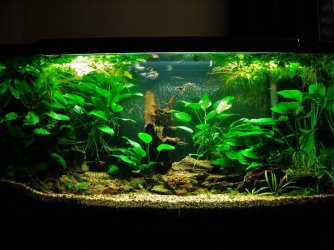There seems to be some confusion earlier in this thread concerning
Anubias plants. I researched this genus of plants when I wrote some plant profiles a decade or so ago, for another site.
Anubias barteri
Family: Araceae, Subfamily Aroideae
Common Name: Anubias
Origin and Habitat: Tropical central and west Africa. Found in rivers, streams and in marshes. Species in the genus are aquatic or semi-aquatic; Kasselmann (2003) mentions that some species grow better as marsh/bog plants as opposed to fully submersed.
Ideal position in aquarium: May be attached to rock or wood and used throughout the aquarium but not in direct bright light [see comments under Lighting requirements].
Lighting requirements: Low to moderate. It often develops yellowing spots on the leaves in bright light (unless nutrients including CO2 are high), and in most natural aquaria should preferably be grown in shade or under diffused light such as under floating plants. Algae will not be so likely to grow on the leaves in subdued or low light.
Discussion
... [excerpted]
The Araceae is a family of flowering plants in which the flower is borne on an inflorescence known as a spadix which is usually partially enveloped by a leaf-like bract called a spathe. Also known as the Arum family, there are more than 3700 species in 107 genera. The genus Anubias was named by the Austrian botanist Heinrich Wilhelm Schott (1794-1865); the name is that of the Egyptian god Anubias. Schott described the species A. barteri in 1860. A. barteri var. nana was originally described by Adolf Engler in 1899 as a distinct species, Anubias nana; it was reduced to varietal status by Crusio in 1979.
References:
Crusio, W. (1979), "A revision of Anubias Schott (Araceae)," Primitiae Africanae XII, Mededelingen Landbouwhogeschool Wageningen 79 (14), pp. 1-48.
Kasselmann, Christel (2003), Aquarium Plants, Krieger Publishing Company.
The photo attached is the Anubias plant in my 33g tank in 2008. All of these plants are from the same plant, with the rhizome broken apart to provide individual plants. The "parent" was in my 90g for a few years, and I decided to use it in individual sections to plant the 33g. It certainly grew well submersed all those years.


